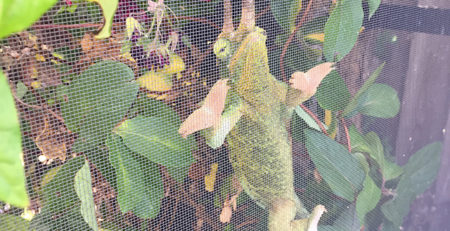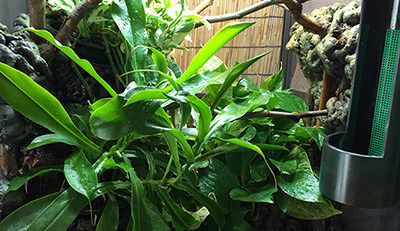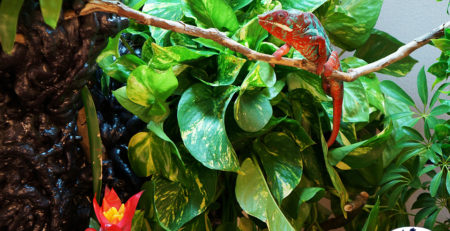Working with “Great Stuff” Expandable Foam
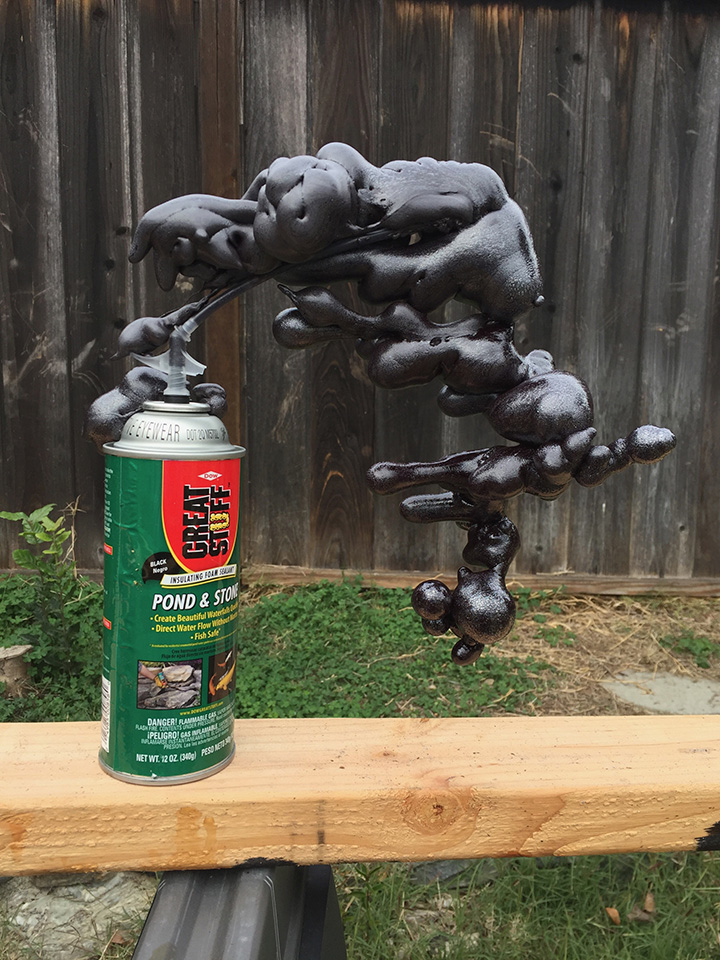
What is Expandable Foam and “Great Stuff”?
Expandable foam is a hardware“Great Stuff” is a certain brand of expanding foam. This foam was designed to be used in home repairs to seal cracks. Reptile keepers have discovered that it works great to create vivarium landscapes. When using Dragon Ledges, we chameleon keepers can get the same benefit to create a floating garden look.
There are a number of brands of expandable foam. The most well known is the “Great Stuff” brand. Whether using Great Stuff or any other I look for the versions designed for repairing fish ponds. For example, the Pond & Stone variety of Great Stuff pictured here. It is designed to repair fish ponds and so is the color black, is designed to work in wet areas, and is non-toxic. Other Great Stuff varieties come out an unnatural cream color and require an extra step of silicone and substrate to look natural. Luis Wiedemann demonstrated how he used the regular foam, coated it with silicone, and then sprinkled natural material into it as it dried. You can check that out here Uroplatus Leaf-tailed Geckos in Dragon Strand Cages

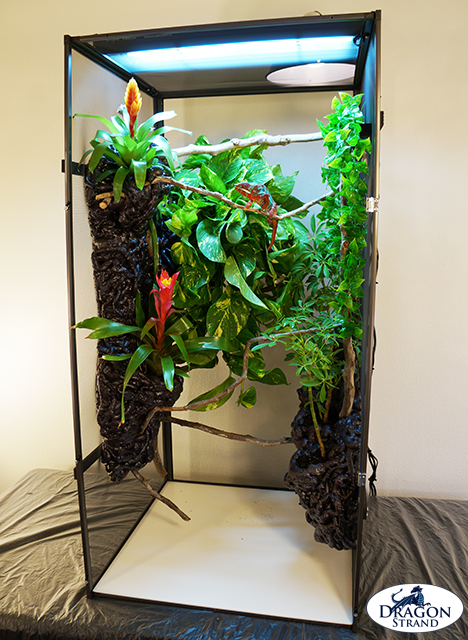
Caution When Using Expandable Foam!
Great Stuff is propelled out with a highly flammable gas and must be used in an area with high ventilation (outdoors) and away from any source of flame. It is a very sticky substance and once it gets on your skin or your clothes it is very difficult to remove. Wear old paint splattered clothes if you have them. It is uncanny how this stuff makes it way places it shouldn’t no matter how careful you are! But once applied and dry, it is safe.
How to use Great Stuff in a Cage
Great Stuff shoots out like shaving cream and then slowly expands until it hardens. I suggest buying a can of the cheaper standard cream colored variety just to experiment and get a feel for how much it expands and how fast.
Each Great Stuff can comes with a dispensing straw. Unless you are quick and talented in cleaning out the straw after use, it will be a one time use. This means that it pays to plan out what you are wanting to do ahead of time. Foam the areas that you know will take the whole can first and leave the accent touch ups for last. The challenge we chameleon keepers have is that we are designing in 3D space up in mid-air. Most projects I do require a multi step process of doing one side, allowing it to dry, and then turning the cage over to do another side.
When you spray the foam out it will stick, but can fall if there is too much weight to the foam mass. You will have to be a quick and dynamic sculptor. The foam will expand and start hardening as soon as it is out of the can. The area exposed to the air will harden first. If you make a big enough mound of foam the outside will harden while the inside continues to expand. In this case you will have the inside burst through the outer shell for an unexpected result. In some cases have had incredible contours I could never have purposely designed in and in other cases I have had a mess. It is always an adventure!
When applying the foam you may squirt it directly on the surface of the cage wall or, in the case of a screen wall, putting the end of the nozzle directly on the outside surface. Squirting through the screen is a great way to fill in hard-to-reach gaps.
You can use Great Stuff to
1) Hide connection hardware (like zip ties)
2) Make a junction of branches, pots, and Dragon Ledges one strong, solid piece
3) Make small rock cropping-like accents
4) Make small pots. (Since Great Stuff hardens so well you can actually carve out a hole in a fully cured mound, drill a drainage hole, fill it with soil, and plant an accent plant.)
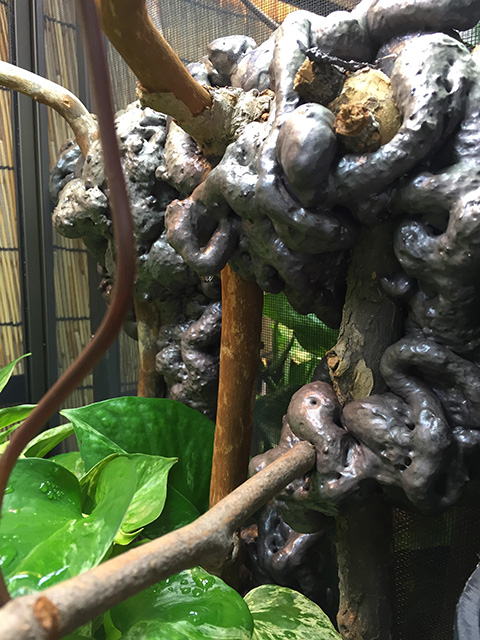

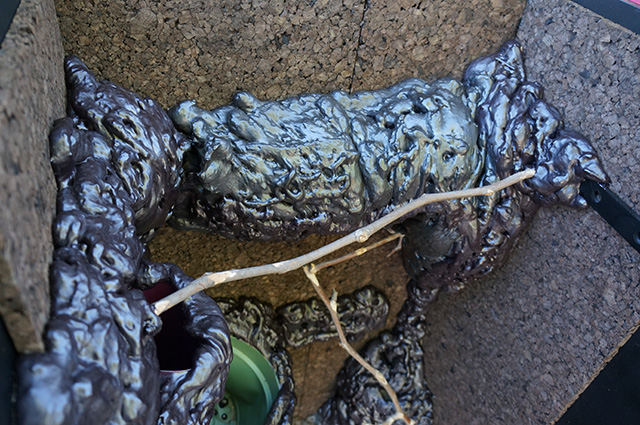
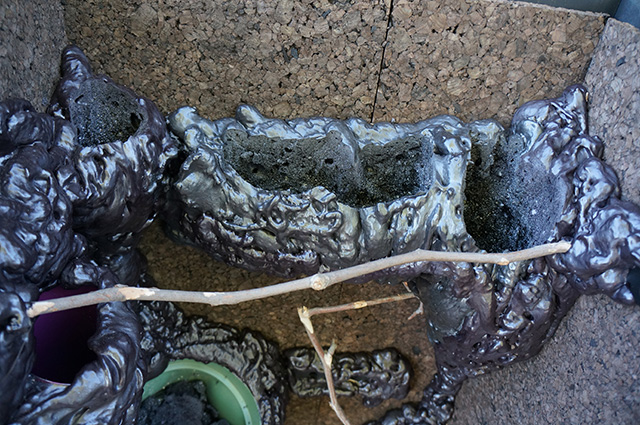

During expansion, the foam will sometimes squeeze through the screen panels and create a small mound outside the cage. This is harmless and you can leave it if you like or cut it off with a knife. With the clear PVC the expansion may create a bulge. The Clearside will mold to it and, although it is an unexpected, bizarre shape, is not a cause for worry. The clear PVC is quite strong and will not burst easily.

Drainage for your pots, whether plastic or carved, is important. You can leave the bottom of the pots hidden from view, free of foam, or you can use a standard drill to create a hole in the dry foam. You can also stretch a length of 1/4” drip system tubing through the area you want drainage and foam over it. Leave a generous length above and below so the foam does not expand over your ends. When the foam is dry you cut the tubing down to size and you have created a drainage pipe. If you are digging a planting hole in the dried foam then simply dig around the length of tubing coming out the top.
Application
Keep the shipping box pieces as a great work surface. When applying foam remember to make it a point to foam all around and under/over the Dragon Ledges so you make one solid piece of the Dragon Ledges, branches, and pots.
1) You do not have to cover every surface, just the ones that can be seen from the front. Use black pots!
2) Leave the bottoms free of foam for drainage.
3) Beware of creating “caves” that will provide homes for spiders and hiding places for escaped feeders
4) Pictured is about one can of Great Stuff
Completing the Application
It is safest to do one side and then wait a day for it to dry and do the next side. If you turn the cage too soon and a clump of foam falls it is miserable trying to recover the look. Great Stuff is not easily cleaned up. If you do get some smeared somewhere unintentionally you can spray a little more and create a visual accent for aesthetic purposes only and hide the smear.
Once branches are firmly anchored by zip ties and foam let the foam expand around the branches randomly. Note how the branch on the back seems to come in and out of the foam background. The beauty of nature is that it is not predictable or “clean”. It is also not excessive. Avoid the urge to put more in just because you have more foam left. The foam background should functionally anchor your cage elements and provide some visual interest. It should take as little of the internal space as possible.
Remember you will get expansion. Use only the minimum necessary coverage!
Final Thoughts
This build took three cans of Great Stuff Pond & Stone foam. Most of what is seen here will be either hidden behind plants or fade to the background. My purpose for the foam is not to be a visual element itself, but to hide the artificial looking pots and mounting hardware.
In this build I used the foam to go over and hide the tops of the pots of the accent plants. I will plant the greenery directly in the pot. For the main foliage pot I have left the top clear so I can place an already potted plant inside and then, if need be, I can easily remove and replace the potted plant.
Foam is also effective for tricky areas where you were not able to get three anchor points on your pot. The pot in the lower left back area ended up with only two zip ties. The foam was used to immobilize the pot further. Note in this case I blocked the drainage with the foam and had to go in later and drill a hole through the dried foam.



